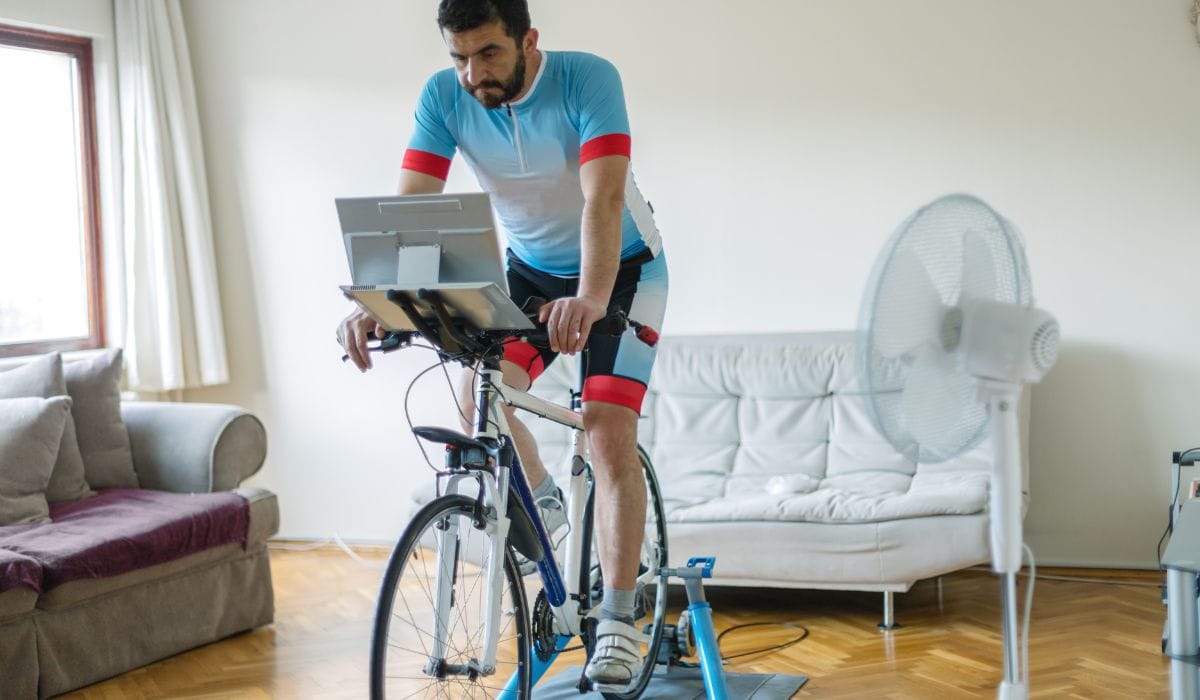
8 Best Health Benefits of Indoor Cycling
If you are new to indoor cycling, you might know how biking or general exercise can improve your health, but do you know the expansive benefits of indoor cycling?
If you are feeling on the fence or want to learn more about what goes on in your body on the bike, check out all these health benefits that happen from getting on your bike.
Is indoor cycling a good workout?

Indoor cycling is a fantastic workout! Not only is it a highly effective way to improve your cardiovascular health, but it’s also ideal for people who can’t put a lot of stress and pressure on their joints. With indoor cycling, you can burn a good number of calories in a short amount of time, improve your endurance and strength, and work muscles throughout your entire body, including your upper body, core, back, glutes, legs, and more! One 2017 study even concluded that indoor cycling was even better than outdoor cycling for improving fitness!1 Let’s look at some of the physical health benefits of biking in more detail below.
What are the physical benefits of indoor biking?

The physical health benefits of indoor cycling are vast—from day-to-day movements and strength to long-term benefits that can impact you far beyond your cycling years.
1. Improve your leg strength
Indoor cycling is a great workout for your legs and a benefit of indoor cycling. Each time you pedal, your glutes, quadriceps, calves, and hamstrings have to work.
- Glutes: The powerhouse really of the lower body. Your glutes are a big part of the strength of your pedal.
- Hamstrings: These are crucial for pushing the pedal down and pulling the pedal up.
- Quads: Another power part of the lower body, and most responsible for that pushing down pedal action. Research also found that even low-impact cycling programs increase overall quadriceps.1
- Calves: The moment when your toes hit the pedal, your calves activate!
- Shins: Help you pull your legs back up after the downstroke of the pedal.
By doing indoor cycling and doing other strength-building exercises, you can build strength in your legs. And having stronger legs overall helps you with functional movement, prevents injury in other parts of your body, and improves joint function.
2. Helps with overall balance and coordination
Remember when you were a kid and had training wheels on your bike? Well, there was a reason for that—to help you balance!
Another benefit of indoor cycling is that it can help improve your balance and overall coordination through the simple repetitive movements of pedaling and staying upright-even on a stationary bike.2
Research on the benefits of indoor cycling also shows that indoor cycling can be especially beneficial for those recovering from strokes and who need balance training. In fact, in this study, they used virtual reality and cycling as a way for stroke survivors to regain balance.3
3. Maintain and lose weight
Biking isn’t just a fun hobby. With consistency, a benefit of indoor cycling is losing weight! Indoor cycling and aerobic exercise, in general, can be beneficial for losing body fat and reaching a healthy weight. One study found that those participating in aerobic activity at both high and low intensity lost significant body fat.4
Regardless of your body type, the CDC recommends you do an aerobic activity (like indoor cycling) every week for at least 75 minutes a week (high-intensity) or 150 minutes (low-intensity) to maintain a healthy weight. 5
4. Supports lung health
Whether you have a lung condition or not, the benefits of indoor cycling can support your lungs. When you ride your bike, your body produces more oxygen and more carbon dioxide. To meet that demand, your lungs have to work harder to breathe. But with time, your muscles can get stronger, decreasing the demand on the lungs and the amount of air you need. 6
5. Improves heart health
In scientific terms, often referred to as cardiovascular fitness, your heart health is simply how well your heart takes in oxygen and delivers it to your muscles and health.
Cardiovascular fitness is incredibly important as it helps mitigate your risk for heart disease, one of the leading causes of death in the US.
Researchers have shown the benefit of indoor cycling can improve overall cardiovascular fitness, and consistent cycling (like commuting or exercising) has even been shown to improve risk factors for heart disease.7
6. Decrease your risk of high blood pressure
Blood pressure is another common health concern in the US, with over 30 million cases of hypertension (high blood pressure) every year. One out of every two Americans already experiencing high blood pressure or taking medication for it. 8
General exercise can help keep blood pressure in healthy ranges, but the benefit of indoor cycling has explicitly been shown to help mitigate risk or lower blood pressure. In one study, indoor cycling routinely decreased blood pressure by 3–4% for sedentary adults. 9
In another study, they found another benefit of indoor cycling: lowering the risk of premature death for those with diabetes. This was a particularly interesting finding, given that it showed that taking up cycling had a strong association with better diabetic outcomes. 10
Implementing a daily biking routine (or any movement) is a great way to decrease your risk or help maintain healthy blood pressure levels.
What are the mental benefits of indoor biking?

In addition to all the wonderful physical benefits of indoor cycling, you may also find some mental benefits of indoor cycling. Fitness is an important aspect of mental health, and indoor cycling is one way you can tap into the benefits of movement for the mind.
7. Improve cognitive function
One study found, in particular, found that those who indoor cycled had better executive function and processing speed than those who didn’t cycle; another benefit of indoor cycling. This also included both e-bikes and outdoor bikes, and researchers found both improved these cognitive functions.11
8. Enhance wellbeing
In addition, studies have shown that indoor cycling benefits include an enhancement of overall well-being, including sleeping better. In one particular study, they surveyed over 1.2 million people and found that all exercise types lowered the overall mental health burden. However, in their scale of mental health burden, which ranged from 11.8%-22.3%, they found specifically those that cycled had a 21.6% lower mental health burden. 12
In addition to being a great way to alleviate mental health burdens and improve well-being, indoor cycling is particularly helpful for those that suffer from mental health diseases. For example, in one study, they found that people diagnosed with schizophrenia who cycled improved brain connectivity. 13
Not sure where to begin?
Check out Vingo.fit/bike! With Vingo you can join from any indoor bike—hop on a trail and explore, and go for a quick ride. We have options of all lengths and terrains so you can choose what’s best for you. Learn more about Vingo here.
Key takeaways:
If improving physical health in the short term and long term is something you are looking for in exercise, cycling may be a great option. Biking offers you ways to strengthen your body and improve physical function. From daily actions like leg strength needed to walk around, your balance, and mental health. To longer-term health outcomes, like lung health and heart health, cycling can have a positive impact.Sources
- Yoon, J. G., Kim, S. H., & Rhyu, H. S. (2017). Effects of 16-week spinning and bicycle exercise on body composition, physical fitness and blood variables of middle school students. Journal of Exercise Rehabilitation, 13(4), 400–404. https://doi.org/10.12965/jer.1735052.526
- Lewis, M. C., Peoples, G. E., Groeller, H., & Brown, M. A. (2018). Eccentric cycling emphasizing a low cardiopulmonary demand increases leg strength equivalent to workload matched concentric cycling in middle age, sedentary males. Journal of Science and Medicine in Sport, 21(12), 1238-1243
- Lee, C. W., & Cho, G. H. (2014). Effect of stationary cycle exercise on gait and balance of elderly women. Journal of physical therapy science, 26(3), 431–433. https://doi.org/10.1589/jpts.26.431
- Yin, C., Hsueh, Y. H., Yeh, C. Y., Lo, H. C., & Lan, Y. T. (2016). A virtual reality-cycling training system for lower limb balance improvement. BioMed research international, 2016.
- Chiu, CH., Ko, MC., Wu, LS. et al. Benefits of different intensity of aerobic exercise in modulating body composition among obese young adults: a pilot randomized controlled trial. Health Qual Life Outcomes 15, 168 (2017). https://doi.org/10.1186/s12955-017-0743-4
- https://www.cdc.gov/healthyweight/physical_activity/index.html#:~:text=To%20maintain%20your%20weight%3A%20Work,maintain%20your%20weight%20over%20time.
- Your lungs and exercise. (2016). Breathe (Sheffield, England), 12(1), 97–100. https://doi.org/10.1183/20734735.ELF121
- Oja, P., Titze, S., Bauman, A., De Geus, B., Krenn, P., Reger‐Nash, B., & Kohlberger, T. (2011). Health benefits of cycling: a systematic review. Scandinavian journal of medicine & science in sports, 21(4), 496-509.https://www.researchgate.net/profile/Bas-De-Geus/publication/51054095_Health_benefits_of_cycling_A_systematic_review/links/5b3a4dcca6fdcc8506ea3547/Health-benefits-of-cycling-A-systematic-review.pdf
- National Center for Chronic Disease Prevention and Health Promotion, Division for Heart Disease and Stroke Prevention. (2021, July 19). Facts about hypertension. Retrieved from: https://www.cdc.gov/bloodpressure/facts.htm
- Huang, G., Shi, X., Gibson, C. A., Huang, S. C., Coudret, N. A., & Ehlman, M. C. (2013). Controlled aerobic exercise training reduces resting blood pressure in sedentary older adults. Blood pressure, 22(6), 386-394. https://www.tandfonline.com/doi/full/10.3109/08037051.2013.778003
- Ried-Larsen M, Rasmussen MG, Blond K, et al. Association of Cycling With All-Cause and Cardiovascular Disease Mortality Among Persons With Diabetes: The European Prospective Investigation Into Cancer and Nutrition (EPIC) Study. JAMA Intern Med. 2021;181(9):1196–1205. doi:10.1001/jamainternmed.2021.3836
- Chekroud, S. R., Gueorguieva, R., Zheutlin, A. B., Paulus, M., Krumholz, H. M., Krystal, J. H., & Chekroud, A. M. (2018). Association between physical exercise and mental health in 1· 2 million individuals in the USA between 2011 and 2015: a cross-sectional study. The Lancet Psychiatry, 5(9), 739-746.
- Alena Svatkova, René C.W. Mandl, Thomas W. Scheewe, Wiepke Cahn, René S. Kahn, Hilleke E. Hulshoff Pol, Physical Exercise Keeps the Brain Connected: Biking Increases White Matter Integrity in Patients With Schizophrenia and Healthy Controls, Schizophrenia Bulletin, Volume 41, Issue 4, July 2015, Pages 869–878, https://doi.org/10.1093/schbul/sbv033




